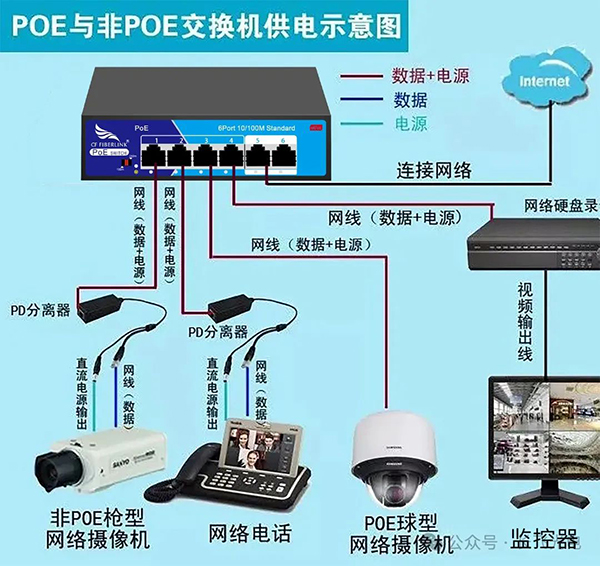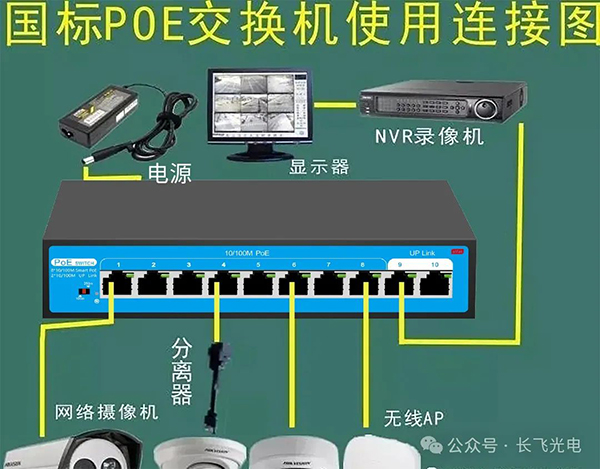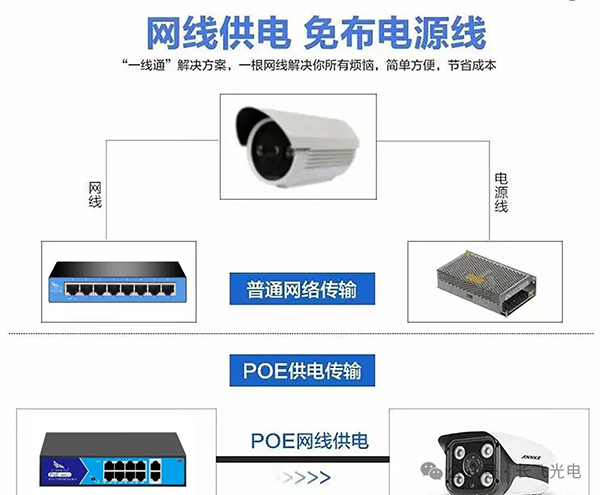We all know that many intelligent subsystems can now use POE switches, such as monitoring, such as visual doorbell, but do you know the maximum transmission distance of POE power supply is how much?

In fact, to answer the question of the maximum transmission distance of PoE, we must first figure out what is the key factor determining the maximum distance? In fact, the transmission of direct current with standard Ethernet cables (twisted pair) can be transmitted far, the distance is far greater than the transmission distance of the data signal, so the maximum distance of data transmission is the key.
Friends who know more about the network know that twisted pair has an "impassable" "100 meters" transmission distance, whether it is three types of twisted pair with 10M transmission rate, or five types of twisted pair with 100M transmission rate, or even six types of twisted pair with 1000M transmission rate, the farthest effective transmission distance is 100 meters. In the integrated wiring specification, it is also clearly required that the horizontal wiring cannot exceed 90 meters, and the total length of the link cannot exceed 100 meters. In other words, 100 meters is a limit for wired Ethernet, and this limit is the length of the link from the network card to the collector device.

So how did you get the maximum distance of 100 meters? What causes the 100-meter transmission distance limit of twisted pair?
This brings us to the deep physics of twisted pair.The transmission of the network, in fact, is the transmission of the network signal on the twisted pair, as an electronic signal, when transmitted in the twisted pair, it must be affected by the resistance and capacitance, which leads to the attenuation and distortion of the network signal. When the attenuation or distortion of the signal reaches a certain degree, the effective and stable transmission of the signal will be affected. Therefore, the twisted pair has a transmission distance limit, so how to calculate the upper limit of 100 meters?

Class 5 UTP, super Class 5 UTP is mainly for the computer network service, according to the fast Ethernet 100Base-TX provisions, its communication rate is 100mbps, 100mbps Ethernet to transmit 1 bit of data spent time (also known as "bit time") can be calculated as follows:
1 bit time = 1/100Mbps =10ns
Ethernet uses CSMA/CD (Carrier Sense Multiple Access with Collision Detection), that is, carrier monitor multiple access with collision detection technology (carrier monitor multiple access/collision detection) to share communication channels. We still need this technology. If devices are connected to both ends of a link, the two devices may send data at the same time, resulting in a conflict. In this case, the conflict zone is 2. Conflicts will result in lost packets. In order to avoid packet loss caused by conflicts, Ethernet uses conflict detection and backward retransmission technology. In order to backtrack and retransmit, one end must be able to detect a collision before sending a packet. The minimum frame length on Ethernet is 64 bytes, or 512 bits. At the rate of 100mbps, it takes time to transmit 512 bits 512 bits *10ns=5120ns.

When the data information is transmitted in the network, there will be a delay when passing through different components, and the delay of the five types of UTP is 5.56ns/m. When designing Ethernet, you need to follow a relay rule, also known as the golden rule or 5-4-3-2-1 rule, which applies not only to 10mbps Ethernet, but also to fast Ethernet. This rule requires that the loop collision delay should not exceed 512 bits, which is 5120ns for 100mbps transmission rates. In the loop, the network components have cable, trunk unit, MAU and DTE, etc., add up their delay and multiply by 2, that is, the loop delay is obtained, and the loop conflict diameter can also be calculated. According to this theory, the maximum distance that the signal can be transmitted before a minimum frame is sent can be calculated. This is why the link span is limited to 100 meters.

When more than 100 meters, because the conflict cannot be detected in time, the information packet damaged by the conflict is transmitted and received by the receiver, the information packet is discarded because it cannot be verified, and the mechanism of backward retransmission is not activated, so the packet is lost. When the transmission rate is less than 100 mbps, in practical applications, the 100-meter limit can be appropriately relaxed. It must be stated that while this is effective, it does not meet the criteria. In the certification test, it must be explained, otherwise there may be some problems, such as product warranty.
So what is the maximum transmission distance of POE power supply? In summary, when using PoE power supply, why is it stipulated that the maximum length of the network cable should not exceed 100 meters, but in actual construction, in order to ensure the quality of the project, generally take 80-90 meters, note that the transmission distance here refers to the maximum speed, such as 100M, if the rate is reduced to 10M, The transmission distance can usually be extended to 150-200 meters (depending on the quality of the network line). Therefore, the transmission distance of PoE power supply is not determined by PoE technology, but by the category and quality of the network cable.

Although in actual construction, the quality of the cable can break through the 100-meter distance limit, the equipment can also work normally, but this practice is not recommended. Because some potential problems do not appear immediately, but slowly over time, which can cause maintenance problems later on. In the simplest case, such as the upgrade of bandwidth, the device that can work normally at more than 100 meters will not work properly after the network speed is greatly increased.
Five types of cable (Cat 5) is now the most common standard network cable on the market, but the quality of different manufacturers vary greatly, especially in the domestic price-oriented environment, many manufacturers in order to reduce costs, copper wire with copper clad iron, copper clad steel replacement, resulting in cable transmission distance decline, and even network instability, packet loss and other phenomena. And equipment manufacturers often take the blame, it is really wrong. Therefore, if you want to make PoE play the best effect, you must use good quality network cables, can not be small and lose big, affecting the overall quality of the project.

Super five type cable (Cat 5e) : Compared with the five type twisted pair, super five type twisted pair attenuation and cross talk is smaller, can provide a more solid network foundation, meet most application requirements (especially support gigabit Ethernet 1000Base-T cabling), to the network installation and testing has brought convenience, become the best solution in the current network application. The transmission characteristics of super five type lines are the same as those of ordinary five type lines, but the super five type wiring standard stipulates that all four pairs of super five type cables can achieve full-duplex communication.

Class 6 cable (Cat 6) : The transmission frequency of this type of cable is 1MHz ~ 250MHz, and the Class 6 cabling system should have a larger margin at 200MHz, which provides twice the bandwidth of the super Class 5. The transmission performance of Class 6 cabling is much higher than that of Class 5 standards, and it is most suitable for applications with transmission rates higher than 1Gbps.
An important difference between Class 6 and Class 5 is improved performance in terms of crosstalk and return loss, which is extremely important for the next generation of full-duplex high-speed network applications. The basic link model is cancelled in the six types of standards, and the wiring standard adopts the star-shaped topology structure, requiring the wiring distance to be: the length of the permanent link cannot exceed 90 meters, and the channel length cannot exceed 100 meters.

There is no strict difference between six class lines and super five class lines in the transmission distance, that is, the maximum transmission distance of a single segment is 100 meters. Of course, the six types of lines can be appropriately increased in the transmission distance, and the so-called 100 meters refers to the inability to meet the relevant technical indicators such as 1000M bandwidth after exceeding it, bringing about problems such as speed decline.
Post time: Aug-24-2024

